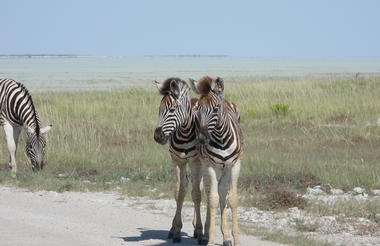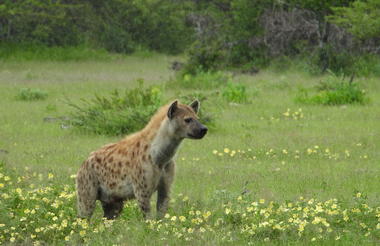One of the largest and oldest national parks in Africa, Etosha National Park is Namibia’s premier tourist destination and a true showcase of the country’s wildlife. The park is home to 114 species of large and small mammals, over 400 recorded bird species, numerous reptiles, and even a unique species of fish, making it a haven for wildlife enthusiasts. Although its boundaries have been reduced since it was first proclaimed in 1907, Etosha still covers an area larger than several European countries, underscoring its immense scale and ecological significance.
The name “Etosha” originates from the Oshindonga word Etotha, meaning “the place where no plants grow.” Early European traders, finding the original pronunciation challenging, adopted the name “Etosha.” The pan itself was once part of the vast Lake Kunene, fed by the Kunene River, which dried up long ago, leaving the spectacular salt pans that define the park today. Fossils recently unearthed — including those of marsh-dwelling antelopes such as sitatunga, lechwe, and tsessebe, as well as a 90-centimeter-long catfish — reveal that this region once experienced much wetter conditions.
Etosha has earned a global reputation for its conservation efforts, particularly for the black rhinoceros, while white rhinos have been successfully reintroduced in recent years. The park has also been instrumental in the recovery of the endemic black-faced impala, further highlighting its critical role in preserving Namibia’s unique biodiversity. Its Etosha Ecological Research Institute continues to attract scientists from around the world, making the park not only a destination for travelers but also a center of important ecological research.



Discover Etosha East, a lesser-known but spectacular region of Namibia’s iconic Etosha National Park. This remote part of the park offers a sense of untouched wilderness, where vast open plains, golden savannahs, and peaceful bush camps come together to create a truly immersive safari experience. It is here that you’ll find the magnificent Etosha Salt Pan — an ancient, shimmering expanse covering nearly 5,000 square kilometers. Visible even from space, the pan dominates the landscape and transforms dramatically with the seasons. In the dry season, its white crust stretches endlessly beneath wide blue skies, while during the rains, it can become a shallow lake, attracting thousands of flamingos and other waterbirds in a breathtaking display of life.
Etosha East is a sanctuary for wildlife enthusiasts and nature lovers alike. Lions, elephants, giraffes, zebras, and even the rare black rhinoceros roam freely through the area, often gathering at the natural and man-made waterholes that dot the terrain. Birdlife is equally rich and rewarding, with ostriches, eagles, hornbills, owls, and countless migratory species filling the air with movement and sound. The landscape itself is a stunning blend of contrast — from stark salt flats to mopane woodland and semi-arid grasslands, offering endless inspiration for photographers and serenity for those seeking solitude.
Thanks to its relative remoteness, Etosha East often feels quieter and more intimate than the busier western side of the park. Whether you're a seasoned safari-goer or visiting for the first time, the region promises unforgettable wildlife encounters, breathtaking scenery, and a deep connection to the rhythms of nature. For those looking to step off the beaten path and into the heart of Namibia’s wild beauty, Etosha East is a destination not to be missed.








